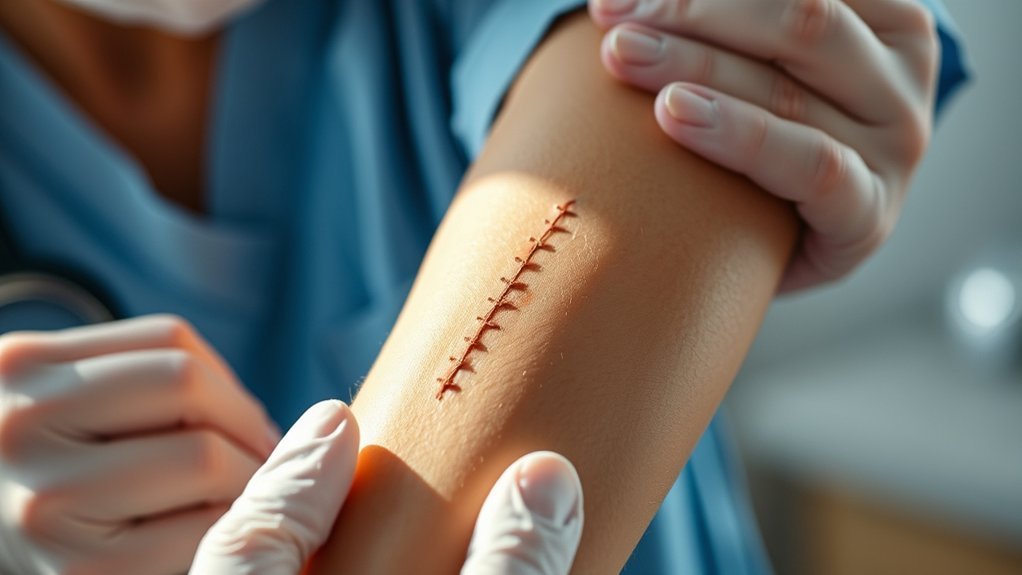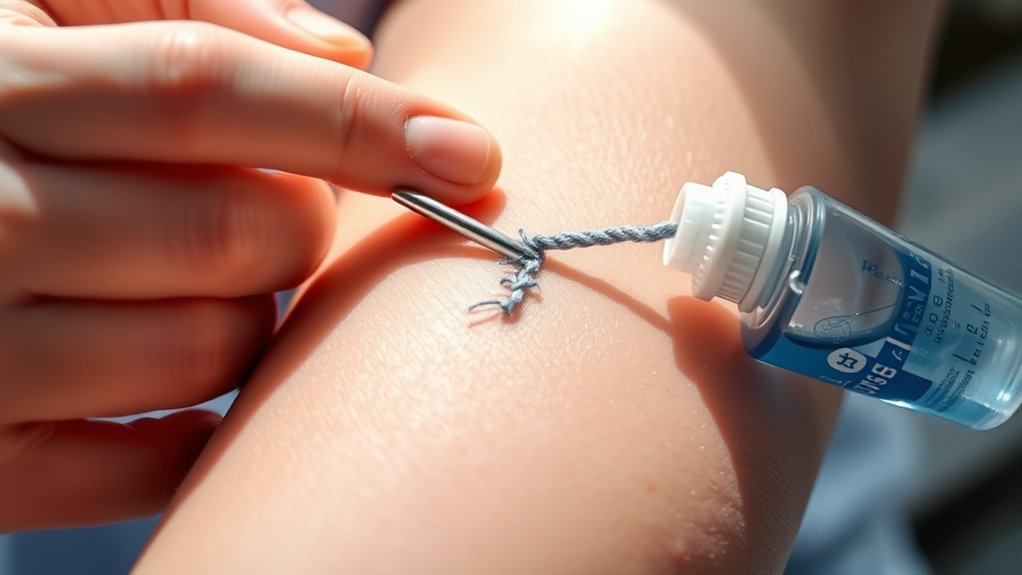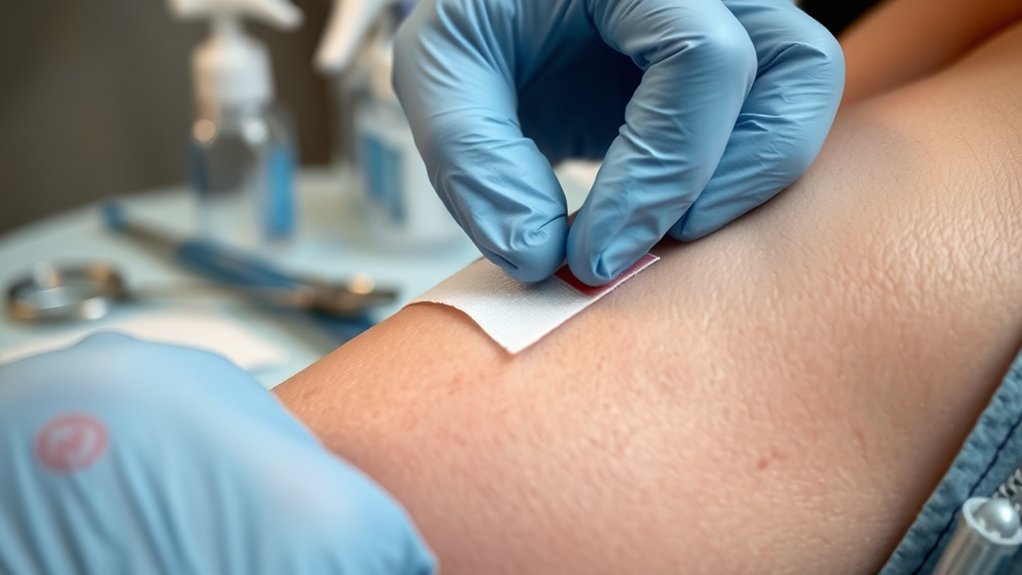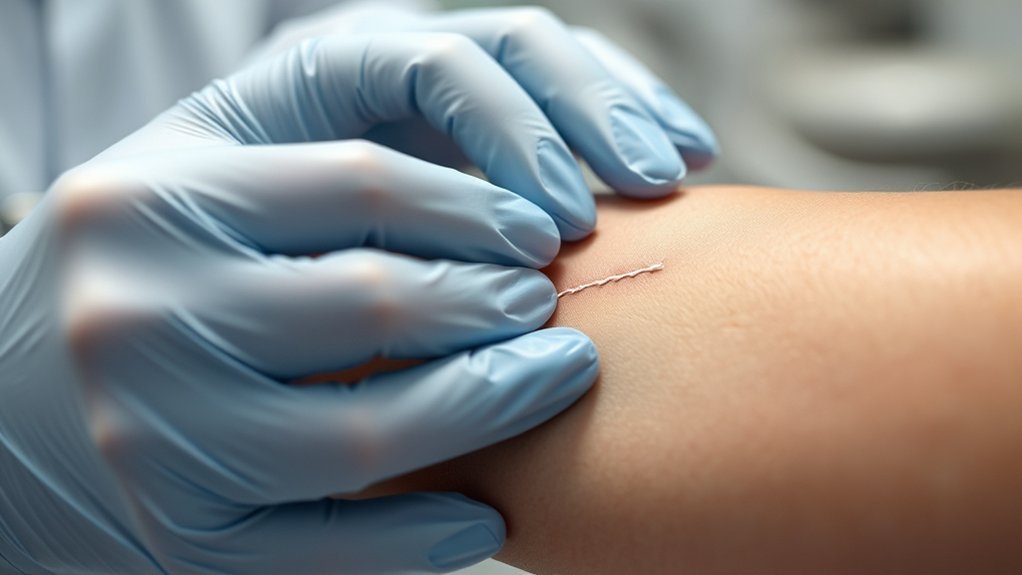Just like a skilled craftsman knows the importance of proper tools, you need to understand how to care for your stitches to guarantee ideal healing. It’s not just about keeping the area clean; there are specific steps you should follow to prevent complications. Curious about what those steps are and when to seek help? Let’s explore the essential FAQs surrounding stitches care.
What Are Sutures?
Sutures, or stitches, are important tools in wound care, designed to hold the edges of a cut or incision together during the healing process. They promote faster recovery by guaranteeing that your skin heals properly.
Stitches can be made from various materials, including silk and nylon, tailored to the wound’s needs. Some stitches dissolve naturally, while others need removal by a healthcare professional after your skin has healed.
Stitches come in various materials, with some dissolving naturally while others require professional removal after healing.
It’s essential to monitor your stitches closely to prevent infection and minimize scarring. Proper care during the healing process is significant, as it helps guarantee that your wound closes effectively and reduces the risk of complications.
Always follow your healthcare provider’s advice regarding suture care and removal.
How Can I Care for My Sutures?
How can you guarantee your sutures heal properly? Start by following your care instructions closely.
For the first 24 to 48 hours, keep the suture area clean and dry to promote healing and prevent infection. Gently wash around the stitches 1 to 2 times a day with cool water and mild soap, avoiding direct contact to prevent irritation.
Change the dressing daily or as directed by your healthcare provider, ensuring the area is clean before applying a new bandage.
Keep an eye out for signs of infection, like increased redness, swelling, or drainage. If you notice any of these symptoms, contact your healthcare provider immediately.
Avoid soaking in baths or swimming until your wound closure is complete.
How Do I Prevent or Minimize Scarring?
Taking care of your sutures is an essential step not just for healing, but also for preventing or minimizing scarring.
Keep your wound clean and dry, especially during the initial healing phase, to help your wound heal effectively. Avoid picking at stitches or scabs, as this can lead to complications and increase scarring risk.
Keep your wound clean and dry to promote effective healing and avoid complications that can increase scarring.
Sun protection is crucial; UV exposure can darken scars and make them more noticeable. Your healthcare provider may recommend silicone gel sheets or scar creams to reduce visibility during recovery.
Always follow medical advice for wound care, including timely dressing changes and monitoring for signs of infection, to further minimize scarring outcomes once your stitches are removed.
How Long Will My Wound Take to Heal?

When it comes to wound healing, several factors come into play, including the type of injury and your overall health.
You’ll notice signs of healing, such as reduced redness and swelling, as your body works through different stages.
Understanding these elements can help you set realistic expectations for your recovery time.
Healing Time Factors
While healing times can vary, most surgical incisions typically take around two weeks to heal.
Your healing time depends on factors like the wound’s complexity, its location, and your overall health. If you’re older or have conditions like diabetes, you might experience a longer healing process.
Sutures, or stitches, are usually removed between 3 to 14 days after your procedure, depending on how well your wound is healing.
Remember, keeping your wound clean and dry is essential for effective wound care, as it reduces the risk of infection.
Always follow your healthcare provider’s instructions to promote ideal healing and guarantee that you’re monitoring your wound’s progress.
Signs of Healing
Healing from a surgical incision typically involves several key signs that indicate your wound is on the right track. Monitoring these can help guarantee your recovery is smooth. Here’s what to look for:
| Signs of Healing | What to Look For | Timeframe |
|---|---|---|
| Reduced redness | Skin color returning to normal | 1-2 weeks |
| Decrease in swelling | Less puffiness around the area | 1-2 weeks |
| Formation of a scab | Protective covering over incision | 3-14 days |
Keep the area clean and dry, and follow your care instructions. If you notice any signs of improper healing, consult your healthcare provider. Stitches or staples are usually removed based on these signs, typically within 3 to 14 days.
When Should My Sutures Be Removed?

Determining the right time for suture removal is essential for proper healing and preventing complications.
Generally, stitches need to be removed within 3 to 14 days after placement, depending on the wound’s location and type. Absorbable sutures dissolve on their own within 1 to 2 weeks, so you won’t need to have them removed.
If your stitches are in areas with greater tension or on your face, they may need to be taken out sooner. Always consult your healthcare provider to establish the best timing for removal based on your individual healing progress.
When Should I Get My Sutures Checked?
How can you tell if your sutures need to be checked? If your wound re-opens or shows no improvement after five days, it’s time to check in with your healthcare provider.
Keep an eye out for increased redness, swelling, or drainage from the wound, as these could indicate complications. If you notice any ooze or pus, don’t hesitate to contact your provider for evaluation.
A fever exceeding 100°F (37.7°C) within 48 hours of stitching is another red flag that requires prompt attention to rule out infection.
Finally, regularly inspect your stitches for signs of premature removal or unusual pain, which may also necessitate a visit to your doctor. Staying vigilant can help guarantee your healing process goes smoothly.
Important Tips for Stitches Care
After ensuring your sutures are stable and free from complications, it’s crucial to focus on proper stitches care to promote healing. Here are some important tips to follow:
| Tip | Details |
|---|---|
| Keep it clean | Clean the incision site as directed by your provider. |
| Keep it dry | Avoid soaking the wound; use waterproof bandages while showering. |
| Change dressings | Change your dressing daily to maintain hygiene. |
| Limit physical activity | Avoid tight clothing and strenuous activities to prevent reopening the incision. |
When to Call the Doctor

If you notice redness, pain, or yellow pus around your stitches, it’s time to call your doctor, as these could be signs of infection.
Don’t hesitate to seek medical help if bleeding doesn’t stop after applying pressure for 10 minutes.
Prompt attention can prevent complications and guarantee proper healing.
Signs of Infection
Recognizing the signs of infection is essential for ensuring proper healing after an injury or surgery. Look for increased redness, swelling, or yellow pus around the wound, as these could indicate complications requiring attention.
If you experience persistent pain at the site, even with pain medication, consult your healthcare provider. A fever of 100°F (37.7°C) or higher within 48 hours of surgery is another red flag.
Additionally, new numbness or tingling sensations around or beyond the wound may suggest nerve involvement, warranting further evaluation.
Don’t hesitate to reach out to your healthcare provider if you notice any of these signs of infection; early intervention can prevent more serious complications down the line.
Uncontrolled Bleeding Issues
Uncontrolled bleeding from a stitched wound can be alarming, and knowing when to seek medical help is essential for your safety.
If the bleeding doesn’t stop after applying direct pressure for 10 minutes, you should seek medical attention immediately. Persistent bleeding may require further evaluation, especially if you notice swelling or increased pain.
Additionally, keep an eye out for signs of infection, such as redness, warmth, or yellow pus around the wound. A fever of 100°F (37.7°C) or higher within 48 hours of getting stitches may also necessitate a consultation with your healthcare provider.
Finally, new numbness or tingling around the area could indicate nerve involvement, making it important to assess with a medical professional.
Frequently Asked Questions
Do and Don’ts After Stitches?
After stitches, keep the area clean and dry, change the dressing regularly, and watch for infection signs. Don’t soak the area or pick at the stitches, as these can hinder healing and cause complications.
How Long Should Stitches Be Kept Covered?
Think of your stitches like delicate flowers needing protection. Keep them covered with a sterile bandage for the first 24 to 48 hours, then assess if further coverage is necessary to fend off irritation or exposure.
Should I Cover My Stitches or Let Them Breathe?
You should cover your stitches initially to protect them from dirt and bacteria. After 24-48 hours, you can let them breathe briefly, but always reapply a clean bandage to maintain proper hygiene.
What to Avoid During Stitches?
Did you know that about 30% of wound complications arise from improper care? You should avoid soaking, picking at stitches, tight clothing, creams, and strenuous activities to guarantee your stitches heal properly and minimize risks.
Conclusion
Taking care of your stitches is like tending to a delicate garden; with the right attention, it’ll flourish and heal beautifully. By keeping the area clean, watching for infection, and following your doctor’s advice on suture removal, you’ll pave the way for a smooth recovery. Remember, if anything seems off, don’t hesitate to reach out to your doctor. Your health is worth nurturing, and every step you take brings you closer to healing.
